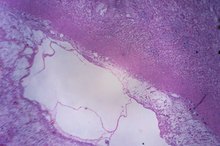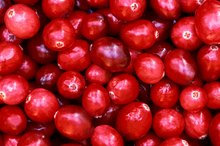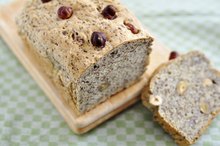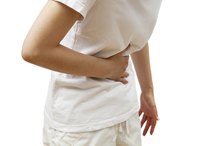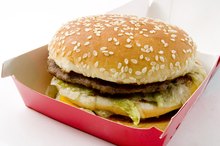Diet for a Slow-Emptying Stomach
Gastroparesis – also known as slow-emptying stomach – is a condition where the muscles in the stomach don’t work properly, causing food to linger in the stomach longer than normal. Gastroparesis can cause nausea, vomiting, bloating, a lack of appetite and acid reflux. A special diet can help lessen the effects of gastroparesis and help your stomach function more normally on a regular basis.
If you are experiencing serious medical symptoms, seek emergency treatment immediately.
Volume
The amount of food you eat is often one of the most important considerations to a gastroparesis diet, according to the University of Virginia Health System. Over-filling a slow-emptying stomach leads to poor digestion and food sitting in the stomach, causing bloating and discomfort. Furthermore, filling up on poor-nutrient food – such as fast food or junk food -- then prevents you from getting the nutrients your body requires later in the day as you will be too full to eat more nutrient-rich food. Eat smaller meals more often in order to avoid over-filling your stomach.
- The amount of food you eat is often one of the most important considerations to a gastroparesis diet, according to the University of Virginia Health System.
- Furthermore, filling up on poor-nutrient food – such as fast food or junk food -- then prevents you from getting the nutrients your body requires later in the day as you will be too full to eat more nutrient-rich food.
Fat Intake
What Foods Should You Eat After a Stomach Virus?
Learn More
High-fat foods slow the digestive process, since it takes your stomach longer to break them down. That’s why your doctor may give you a low-fat diet to follow if you have gastroparesis. Aim for lean proteins such as fish, chicken or turkey breast, and beans and nuts rather than fattier red meats. Switching to skim milk over whole milk and opting for low- or non-fat cheeses and yogurts can help your stomach empty more quickly.
- High-fat foods slow the digestive process, since it takes your stomach longer to break them down.
- That’s why your doctor may give you a low-fat diet to follow if you have gastroparesis.
Fiber Intake
Fiber is another nutrient that your body takes longer to digest, meaning it can exacerbate your slow-emptying stomach symptoms. You may need to reduce your overall fiber intake, especially raw fruits and vegetables, according to the Ohio State University Medical Center. Avoid pairing up high-fat and high-fiber foods at meal time. Try to get your fiber in during snack times, when you’re less likely to fill your stomach up.
- Fiber is another nutrient that your body takes longer to digest, meaning it can exacerbate your slow-emptying stomach symptoms.
- Try to get your fiber in during snack times, when you’re less likely to fill your stomach up.
Sugar Consumption
Symptoms of Lack of Digestive Enzymes
Learn More
High blood sugar can sometimes impair the digestive system, making it harder for your stomach to empty itself, according to the Ohio State University Medical Center. Avoid processed sugars and use moderation when having sweet snacks such as cake, ice cream or candy.
Liquid Diet
A liquid diet may be a viable alternative for someone with a slow-emptying stomach in order to alleviate symptoms, according to the University of Virginia Health System. Blenderized meals are easier for the stomach to digest and may pass through your system faster than a normal meal. If you feel your stomach filling up, consider a liquid meal for your next meal, such as soup. Fill up on essential nutrients first to ensure your body is getting the proper nutrition you need.
- A liquid diet may be a viable alternative for someone with a slow-emptying stomach in order to alleviate symptoms, according to the University of Virginia Health System.
- Blenderized meals are easier for the stomach to digest and may pass through your system faster than a normal meal.
Related Articles
References
- Parkman HP. Idiopathic gastroparesis. Gastroenterol Clin North Am. 2015;44(1):59-68. doi: 10.1016/j.gtc.2014.11.015
- Liu N, Abell T. Gastroparesis Updates on Pathogenesis and Management. Gut Liver. 2017;11(5):579-589. doi: 10.5009/gnl16336
- Sachdev AH, Pimentel M. Gastrointestinal bacterial overgrowth: pathogenesis and clinical significance. Ther Adv Chronic Dis. 2013;4(5):223-31. doi:10.1177/2040622313496126
- Krishnasamy S, Abell TL. Diabetic Gastroparesis: Principles and Current Trends in Management. Diabetes Ther. 2018;9(Suppl 1):1-42. doi:10.1007/s13300-018-0454-9
- Abrahamsson H. Treatment options for patients with severe gastroparesis. Gut. 2007;56(6):877-83. doi:10.1136/gut.2005.078121
- Sadiya A. Nutritional therapy for the management of diabetic gastroparesis: clinical review. Diabetes Metab Syndr Obes. 2012;5:329-35. doi:10.2147/DMSO.S31962
Writer Bio
James Patterson specializes in health and wellness topics, having written and produced material for the National Institutes of Health, the President's Cancer Panel and an Inc. 500 Hall of Fame company. He is also a former sportswriter with writing experience in basketball, baseball, softball, golf and other popular sports.





